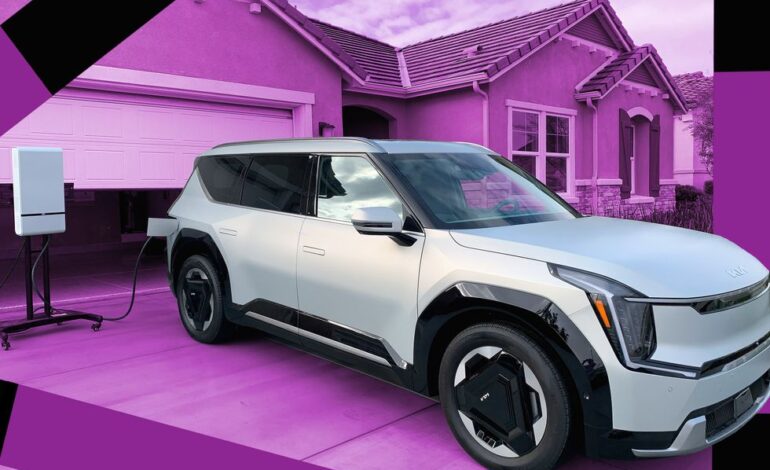Menifee Launches North America’s First EV-Powered Homes

In Menifee, California, a groundbreaking initiative has commenced with the launch of six newly constructed homes that utilize electric vehicles (EVs) to provide power through the Combined Charging System (CCS) high-power direct current (DC) charging standard. Each residence features a Kia EV9 electric vehicle connected to a Wallbox Quasar 2 bidirectional charger, enabling the car’s 100-kilowatt-hour (kWh) battery to supply essential circuits during power outages or periods of high electricity costs. This system marks the first residential vehicle-to-home (V2H) deployment in North America utilizing the CCS standard.
Since July 2023, the smart electrical panels in these homes have been automatically managing two-way power flow. This technology allows the vehicles to charge from the grid or rooftop solar energy and reverse the flow when necessary. During outages, the system isolates each home from the grid, ensuring that no current flows back into external power lines, which protects utility crews and surrounding equipment.
Scott Samuelsen, founding director of the Advanced Power and Energy Program (APEP) at the University of California, Irvine, which is monitoring the two-year trial, stated, “This project is demonstrating that bidirectional charging with CCS can work in occupied homes. It’s a step toward vehicles that not only move people but also strengthen the energy system.”
Innovative Technology in Action
The concept of two-way charging is not new and has been primarily tested in Japan. In 2012, the Nissan LEAF-to-Home program showcased the viability of this technology following the Tōhoku earthquake and tsunami, though it relied on the CHAdeMO standard, which has limited use outside Japan. Most North American and European manufacturers have opted for CCS, which, until recently, only supported one-way fast DC charging. The Menifee project stands out as it is the first CCS-based V2H system deployed in occupied homes, providing researchers with valuable real-world data.
The combination of the Kia EV9 SUV and Wallbox’s commercially available Quasar 2 charger can deliver up to 12 kilowatts of power from the vehicle to the home. Samuelsen further emphasized the significance of the project, noting that it not only enhances energy resilience but also contributes to renewable energy utilization and cost reduction during peak electricity usage.
While interest in commercial V2H systems grows, other manufacturers face challenges. For instance, Ford’s F-150 Lightning supports home backup through Sunrun, yet the equipment is not compatible with CCS. Furthermore, Ford has announced a production pause, delaying expansion efforts. General Motors’ (GM) Ultium Home system, compatible with several of its EV models, also encounters similar setbacks. Meanwhile, Tesla’s PowerShare V2H feature is in a limited rollout, primarily available for the Cybertruck. In contrast, Menifee is generating operational data from actual households.
The Importance of CCS
When electric vehicles were first introduced, CCS was designed primarily for rapid charging from the grid to the vehicle, focusing on reliable and standardized fast charging. This explains the significant difference between CCS public chargers, many rated at 350 kilowatts or more, and CHAdeMO chargers, which typically max out at 100 kW but can provide backup power for homes.
Bidirectional operation was not included in the original CCS standard due to concerns regarding safety, grid interference, and additional hardware costs. The original communication protocol, ISO 15118, did not facilitate power export. However, the 2022 update, ISO 15118-20, introduced secure two-way communication, allowing CCS vehicles to supply energy to buildings and the grid. Wallbox’s Quasar 2 residential charger implements this update with an active-bridge converter circuit that utilizes silicon-carbide transistors to achieve efficient bidirectional flow. With a power rating of 12 kW, it can support typical critical loads in a household, including heating, cooling, refrigeration, and networking, according to Aleix Maixé Sas, a system electronics architect at Wallbox.
The Menifee homes equipped with V2H systems feature rooftop solar arrays and a 13-kWh SunVault stationary battery from SunPower. Under normal conditions, solar energy powers daily household needs while charging the stationary battery. On sunny days, solar panels can also recharge the Kia EV9’s battery. During grid failures or peak energy prices, the homes can isolate themselves, utilizing solar power and energy stored in the SunVault to sustain essential systems and appliances.
This past summer, researchers from the University of California, Irvine, monitored how solar output, stationary storage, and vehicle power interacted amid high summer demand and wildfire-related grid stress. They concluded that the vehicle contributes significantly to household resilience. “It can relieve grid strain, increase renewable utilization, and lower costs by supplying power during peak-rate hours,” said Samuelsen.
Shaping the Future of Energy
The introduction of V2H technology prompts a reconsideration of engineering requirements not only for home builders and electric vehicle service equipment manufacturers like Wallbox, but also for utilities. Adaptations must be made to interconnection procedures and energy pricing structures to accommodate bidirectional power flow.
Analysts predict significant annual growth in bidirectional charging system sales through the late 2020s as costs decline and standards mature. In regions prone to outages from wildfires or storms, as well as areas facing steep time-of-use pricing, projects similar to Menifee’s illustrate a clear path toward utilizing cars as substantial and flexible energy reserves. As electric vehicle batteries become capable of supplying energy to homes with the same ease as they provide propulsion, traditional distinctions between energy suppliers and consumers may begin to blur.






